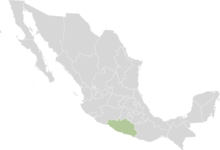Peltogyne mexicana
Peltogyne mexicana is a species that belongs to the family Fabaceae. The genus Peltogyne is also known as Purpleheart, Morao, Nazareno, Violeta or Pau Roxo depending on the region in question. The Peltogyne genus is neotropical and is made up of 23 species. Peltogyne Mexicana is one of the northernmost examples of the Peltogyne genus, found in Guerrero, Mexico. [3]
| Peltogyne mexicana | |
|---|---|
 | |
| Peltogyne mexicana | |
| Scientific classification | |
| Kingdom: | |
| (unranked): | |
| (unranked): | |
| (unranked): | |
| Order: | |
| Family: | |
| Subfamily: | |
| Genus: | |
| Species: | P. mexicana |
| Binomial name | |
| Peltogyne mexicana Martínez | |
 | |
| Natural range of the Peltogyne mexicana species | |
| Synonyms[2] | |
| |
Many of the vernacular names derive from the characteristic of the color of the wood, which is unusually purple in the center. However, the coloration darkens and intensifies with the exposure to air and ultraviolet (UV) light; if it is put in water for a few hours, the purple color changes to intense black. Peltogyne mexicana is considered a precious wood. [4]
Classification and description
The flowers are grouped in inflorescences, from 5 to 8 cm, with peduncles and densely ferruginous-pubescent pedicels. The flowers are white, aromatic, 8 mm in diameter, with the surface covered with beautiful whitish; with four sepals of which only three are visible outside the button, slightly violet or chestnut colored, 3 mm; with five elliptical petals 5 mm long by 2 to 2.5 wide; with 10 stamens, of which five are greater than 7 mm and alternate with the others (5 to 6 mm), are all fertile, with white filaments. The fruit is oblique, compressed, from 3 to 4 cm, with the apex rounded. It is usually covered by a kind of very sticky sap. [5][6] It flowers in August and pollination is carried out by insects. [7]
Distribution and environment
This tree was reported as a new botanical species by Maximino Martínez in 1960. [8]
The distribution of P. mexicana is in Guerrero, Mexico. P. mexicana is a geographic outlier, with most other members of the Peltogyne genus found in South America].[9]
Wood
This species is prized for its beautiful heartwood which, when cut, quickly turns from a light brown to a rich purple color. Exposure to ultraviolet (UV) light darkens the wood to a brown color with a slight hue of the original purple.[10] This effect can be minimized by treating cut wood with a finish or sealant containing a UV inhibitor. The dry timber is very hard, stiff, and dense with a specific gravity of 0.86 (860 kg/m3 or 54 lb/cu ft). Purpleheart is correspondingly difficult to work with.[11]
Uses and hazards
Purpleheart is prized for use in fine inlay work especially on musical instruments, guitar fret boards, woodturning, cabinetry, flooring, and furniture. The timber is also valuable in applications that require toughness, such as truck decking.[12]
Exposure to the dust, generated by cutting and sanding purpleheart, can cause irritation and nausea, possibly due to the presence of dalbergione (neoflavonoid) compounds in the wood. This also makes purpleheart wood unsuitable to most people for use in jewelry.[13] Purpleheart is also a fairly expensive wood, which is why it is usually used in smaller-scale projects.[14]
State of conservation
This species has a category of Endangered species (A) according to NOM-059-ECOL-2010, caused in part by overexploitation and deforestation and compounded by its slow growth. [15][6]
Gallery
 Example of P. mexicana heartwood
Example of P. mexicana heartwood
References
- http://www.fao.org/tempref/docrep/fao/010/ah886e/ah886e00.pdf
- R. C. Barneby (1983). "(711)-(712) Proposals to conserve Plathymenia against Echyrospermum and Peltogyne against Orectospermum (Leguminosae)". Taxon. 32 (3): 488–490. doi:10.2307/1221525. JSTOR 1221525.
- Sotuyo, Solange. "El palo morado (Peltogyne mexicana), una leguminosa maderable con futuro incierto y parientes lejanos". Revista Digital Universitaria, Universidad Nacional Autónoma de Mexico.
- Sotuyo, Solange. "El palo morado (Peltogyne mexicana), una leguminosa maderable con futuro incierto y parientes lejanos". Revista Digital Universitaria, Universidad Nacional Autónoma de Mexico.
- CONABIO. 2009. Catálogo taxonómico de especies de México. 1. In Capital Nat. México. CONABIO, Mexico City.
- Administrator. "Palo morado". www.enciclopediagro.org (in Spanish). Retrieved 6 November 2017.
- Interián-Ku, Víctor Manuel; Rosa, Borja de la; Amparo, María; Valdez-Hernández, Juan Ignacio; García-Moya, Edmundo; Romero-Manzanares, Angélica; Vaquera-Huerta, Humberto (2011). "Características anatómicas y propiedades físicas de la madera de Caesalpinia gaumeri Greenm en Dzan, Yucatán". Madera y Bosques. 17 (1): 23–36. doi:10.21829/myb.2011.1711152. ISSN 1405-0471. Retrieved 6 November 2017.
- Universidad Nacional Autónoma de México; Instituto de Biología (1930). "Anales del Instituto de Biología". Anales del Instituto de Biología (in Spanish). ISSN 0076-7174. OCLC 1641855.
- Sotuyo, Solange. "El palo morado (Peltogyne mexicana), una leguminosa maderable con futuro incierto y parientes lejanos". Revista Digital Universitaria, Universidad Nacional Autónoma de Mexico. Accessed 25 April 2015.
- "PURPLEHEART-PELTOGYNE".
- Garnet Hall (February 2006). The Art of Intarsia: Projects & Patterns. Tamos Books, Incorporated. pp. 16–. ISBN 978-1-895569-75-9.
- "Purpleheart Wood".
- Peltogyne in BoDD – Botanical Dermatology Database
- J. L. Atrops (1970). Strength Properties of Trinidadian Timbers. University of the West Indies.
- Juárez-Agis, Alejandro, Benítez Villasana, José Ignacio, García Sánchez, Silverio, Época de recolecta en Palo Morado (Peltogyne mexicana M.), en Acapulco Gro., México. RIDE Revista Iberoamericana para la Investigación y el Desarrollo Educativo [en linea] 2013, 4 (Julio-Diciembre) : [Fecha de consulta: 6 de noviembre de 2017] Disponible en:<http://www.uacm.kirj.redalyc.redalyc.org/articulo.oa?id=498150315002> ISSN
| Wikimedia Commons has media related to Peltogyne mexicana. |
